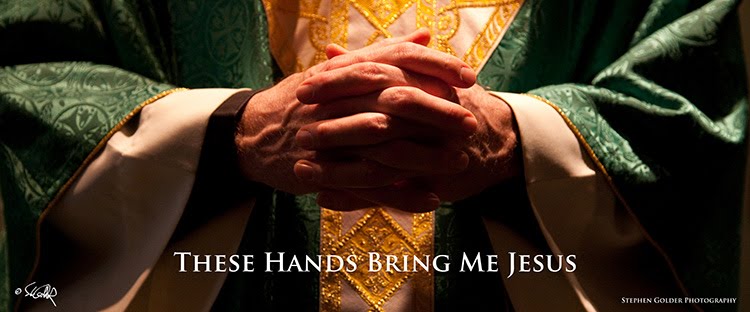Every priest has his own gestures, as typical of the man as his face and conversation. The images in this collection are almost entirely posed; photographing the Mass is a daunting and intrusive process in what is rightfully worship that should be apart from other human concerns, and we did not do it often. Even so, these photographs capture the idioms of the individual priests, and if you know the men, you will recognize their gestures.
No matter how we speak, we do so individually and with accents. Watch the hands of the priest with rapt attention and suddenly, one remembers that God expects us to worship him in body as well as in spirit. For this reason, we kneel, we stand, we genuflect, we make the sign of the cross. For this reason, the physical aspects of the Mass are important. For this reason, God gave us eyes, to see Him in creation and, not the least, to see Him in the beautiful movements of the celebration of the Eucharist. We hope these images capture some of that.
The rhythm of the Mass and of its gestures communicate in a universal way the messages of the Church, as anyone who has heard Mass in a foreign country and an alien tongue will testify. The header of this blog is the title image from These Hands Bring Me Jesus: The Exhibit; it is only one of many images that are Catholic in every sense of the word.
Against the backdrop of a green chasuble, the color of Ordinary time, it is a very familiar image. There is probably no priest, living or dead, who has not assumed this posture at one time or another. The clasped hands are peaceful. They do not grasp or fidget, but rest patiently. Not open in the usual sense, they seem to be waiting to extend themselves in welcome. The fingers are interlaced, but not clenched. There is no anger, no tension, and no need to prove themselves; the hands are authoritative without being overbearing. Entwined with each other, they are ready, expecting to reach out.
It brings to mind a verse of a traditional Irish hymn that links the passage of the day and the passage of life to the strong, patient, loving presence of God:
Lord of all kindliness, Lord of all grace
Your hands swift to welcome, Your arms to embrace
Be there at our homing, and give us, we pray
Your love in our hearts, Lord
At the eve of the day.
In a world that has exploited and diminished, even corrupted, the value of human touch, it is well to remember that it was often by His hands that our Lord communicated His healing grace. He applied a paste of mud to the eyes of a man blind from birth. He touched the ears of the deaf mute. He grabbed Peter by the hand to rescue him from the deep waters when Peter's faith failed. He wrote in the dust to challenge the hearts of those who had caught a woman in adultery. Before He ascended, he stretched out His hands to bless His Disciples.



No comments:
Post a Comment